Case Study of the Application of an Innovative Guide for the Seismic Vulnerability Evaluation of Schools Located in Sangolquí, Interandean Valley in Ecuador
Abstract
1. Introduction
2. Geodynamic Setting and Seismic Vulnerability of Ecuador
3. Study Area and Regional Seismic Hazard
4. Methodology
4.1. General Assumptions
4.2. Safety Requirements in Performance-Based Design
4.3. Vulnerability Degree Assessment Procedure (V)
4.3.1. Base Score (P. Base)
4.3.2. Before the First Construction Code (Pre-Code)
4.3.3. First Ecuadorian Construction Code (CEC 77) (Transition Period)
4.3.4. Ecuadorian Construction Code 2000 (CEC 2000) (Post-Code)
4.3.5. Ecuadorian Construction Standard 2015 (NEC-15) (Modern Code)
4.3.6. Score Modifiers (GV)
4.4. General Aspects of the Schools (GV1 and GV2)
4.4.1. Number of Stories
4.4.2. FEMA Building Type
4.4.3. Tapping and Adjacency
4.4.4. Soil Type
4.4.5. Degree of Vulnerability Associated with Other Parameters
- (a)
- Length-Width Ratio
- (b)
- Irregularities in Plan and Elevation
- (c)
- Vertical-Horizontal Extensions
- (d)
- Pathologies in Structural Systems
4.5. Vulnerability of Nonstructural Elements (GV3)
4.5.1. State of Conservation of the Building and Roofs
4.5.2. Exit Doors or Emergency Exits
4.5.3. Windows
4.5.4. Universal Accessibility
4.5.5. Vulnerability Plugin
4.5.6. Interpretation of the Degree of Vulnerability Score
4.6. Seismic Risk and Global Risk of Schools
4.6.1. Seismic Risk of a Structure (Rs)
4.6.2. Seismic Hazard
4.6.3. Degree of Damage
4.6.4. Global Seismic Risk (Rg)
4.6.5. Hazard Exposure Level (NE)
4.6.6. Response Capacity (Cr)
4.6.7. Calculation of the Capacity Coefficient (C)
4.6.8. Categorization of Schools
5. Results and Discussion
Model of Victims of Schools
6. Conclusions
Author Contributions
Funding
Institutional Review Board Statement
Informed Consent Statement
Data Availability Statement
Acknowledgments
Conflicts of Interest
References
- Anbarci, N.; Escaleras, M.; Register, C.A. Earthquake fatalities: The interaction of nature and political economy. J. Public Econ. 2005, 89, 1907–1933. [Google Scholar] [CrossRef]
- Daniell, J.E.; Khazai, B.; Wenzel, F.; Vervaeck, A. The CATDAT damaging earthquakes database. Nat. Hazards Earth Syst. Sci. 2011, 11, 2235–2251. [Google Scholar] [CrossRef]
- Spence, R. Risk and regulation: Can improved government action reduce the impacts of natural disasters? Build. Res. Inf. 2004, 32, 391–402. [Google Scholar] [CrossRef]
- Cross, J.A. Megacities and small towns: Different perspectives on hazard vulnerability. Glob. Environ. Change Part B Environ. Hazards 2001, 3, 63–80. [Google Scholar] [CrossRef]
- Hobson, C. Human security after the shock: Vulnerability and empowerment. In Human Security and Natural Disasters; Routledge: London, UK, 2014; pp. 22–36. [Google Scholar]
- Farfel, A.; Assa, A.; Amir, I.; Bader, T.; Bartal, C.; Kreiss, Y.; Sagi, R. Haiti earthquake 2010: A field hospital pediatric perspective. Eur. J. Pediatrics 2011, 170, 519–525. [Google Scholar] [CrossRef]
- Palermo, D.; Nistor, I.; Saatcioglu, M.; Ghobarah, A. Impact and damage to structures during the February 27 2010 Chile tsunami. Can. J. Civ. Eng. 2013, 40, 750–758. [Google Scholar] [CrossRef]
- Mimura, N.; Yasuhara, K.; Kawagoe, S.; Yokoki, H.; Kazama, S. Damage from the Great East Japan Earthquake and Tsunami-a quick report. Mitig. Adapt. Strateg. Glob. Change 2011, 16, 803–818. [Google Scholar] [CrossRef]
- Yun, N.Y.; Hamada, M. Evacuation behavior and fatality rate during the 2011 Tohoku-Oki earthquake and tsunami. Earthq. Spectra 2015, 31, 1237–1265. [Google Scholar] [CrossRef]
- Toulkeridis, T.; Chunga, K.; Rentería, W.; Rodriguez, F.; Mato, F.; Nikolaou, S.; Cruz D’Howitt, M.; Besenzon, D.; Ruiz, H.; Parra, H.; et al. The 7.8 Mw Earthquake and Tsunami of the 16 April 2016 in Ecuador—Seismic evaluation, geological field survey and economic implications. Sci. Tsunami Hazards 2017, 36, 197–242. [Google Scholar]
- Toulkeridis, T.; Mato, F.; Toulkeridis-Estrella, K.; Perez Salinas, J.C.; Tapia, S.; Fuertes, W. Real-Time Radioactive Precursor of the 16 April 2016 Mw 7.8 Earthquake and Tsunami in Ecuador. Sci. Tsunami Hazards 2018, 37, 34–48. [Google Scholar]
- Toulkeridis, T.; Porras, L.; Tierra, A.; Toulkeridis-Estrella, K.; Cisneros, D.; Luna, M.; Salazar, R. Two independent real-time precursors of the 7.8 Mw earthquake in Ecuador based on radioactive and geodetic processes—Powerful tools for an early warning system. J. Geodyn. 2019, 126, 12–22. [Google Scholar] [CrossRef]
- Tandazo Regalado, J.E.; Flores Díaz, G.D. Proceso de industrialización de la caña guadua como material alternativo para la construcción y diseño de vivienda tipo de una y dos plantas, empleando caña guadua en sus elementos estructurales. [Tesis de pregrado, Escuela Politécnica del Ejército]. Repos. Inst. 2012. Available online: http://repositorio.espe.edu.ec/xmlui/handle/21000/5892 (accessed on 1 February 2022).
- Akadiri, P.O.; Chinyio, E.A.; Olomolaiye, P.O. Design of a sustainable building: A conceptual framework for implementing sustainability in the building sector. Buildings 2012, 2, 126–152. [Google Scholar] [CrossRef]
- Zhou, Y.; Shao, H.; Cao, Y.; Lui, E.M. Application of buckling-restrained braces to earthquake-resistant design of buildings: A review. Eng. Struct. 2021, 246, 112991. [Google Scholar] [CrossRef]
- Ellingwood, B.R. Acceptable risk bases for design of structures. Prog. Struct. Eng. Mater. 2001, 3, 170–179. [Google Scholar] [CrossRef]
- Toulkeridis, T. The Evaluation of unexpected results of a seismic hazard applied to a modern hydroelectric center in central Ecuador. J. Struct. Eng. 2016, 43, 373–380. [Google Scholar]
- Suárez-Acosta, P.E.; Cañamar-Tipan, C.D.; Ñato-Criollo, D.A.; Vera-Zambrano, J.D.; Galarza-Vega, K.L.; Guevara-Álvarez, P.M.; Fajardo-Cartuche, C.N.; Herrera-Garcés, K.K.; Ochoa-Campoverde, C.V.; Torres-Orellana, J.S.; et al. Evaluation of seismic and tsunami resistance of potential shelters for vertical evacuation in case of a tsunami impact in Bahia de Caráquez, central coast of Ecuador. Sci. Tsunami Hazards 2021, 40, 1–37. [Google Scholar]
- Del-Pino-de-la-Cruz, C.E.; Martinez-Molina, B.D.; Haro-Baez, A.G.; Toulkeridis, T.; Rentería, W. The proposed design of a smart parking area as a multiple use building for the eventual vertical evacuation in case of tsunami impacts in Salinas, Ecuador. Sci. Tsunami Hazards 2021, 40, 146–165. [Google Scholar]
- Toulkeridis, T.; Barahona-Quelal, I.N.; Pilco-Paguay, E.O.; Cacuango-Casco, D.M.; Guilcaso-Tipán, B.S.; Sailema-Hurtado, W.P. Evaluation of seismic and tsunami resistance of potential shelters for vertical evacuation in case of a tsunami impact in Manta and Salinas, central coast of Ecuador. Sci. Tsunami Hazards 2021, 40, 286–314. [Google Scholar]
- Faccioli, E.; Villani, M. Seismic hazard mapping for Italy in terms of broadband displacement response spectra. Earthq. Spectra 2009, 25, 515–539. [Google Scholar] [CrossRef]
- Goltz, J.D.; Park, H.; Nakano, G.; Yamori, K. Earthquake ground motion and human behavior: Using DYFI data to assess behavioral response to earthquakes. Earthq. Spectra 2020, 36, 1231–1253. [Google Scholar] [CrossRef]
- Alvarado, P.; Barrientos, S.; Saez, M.; Astroza, M.; Beck, S. Source study and tectonic implications of the historic 1958 Las Melosas crustal earthquake, Chile, compared to earthquake damage. Phys. Earth Planet. Inter. 2009, 175, 26–36. [Google Scholar] [CrossRef]
- Satake, K.; McLean, C.; Alcántara-Ayala, I. Understanding disaster risk: The role of science and technology. J. Disaster Res. 2018, 13, 1168–1176. [Google Scholar] [CrossRef]
- Comerio, M.C. Public policy for reducing earthquake risks: A US perspective. Build. Res. Inf. 2004, 32, 403–413. [Google Scholar] [CrossRef]
- Cornell, C.A.; Jalayer, F.; Hamburger, R.O.; Foutch, D.A. Probabilistic basis for 2000 SAC federal emergency management agency steel moment frame guidelines. J. Struct. Eng. 2002, 128, 526–533. [Google Scholar] [CrossRef]
- Kreps, G.A. The federal emergency management system in the United States: Past and present. Int. J. Mass Emergencies Disasters 1990, 8, 275–300. [Google Scholar]
- Schneider, S.K. Reinventing public administration: A case study of the Federal Emergency Management Agency. Public Adm. Q. 1998, 22, 35–57. [Google Scholar]
- Sylves, R.T. Federal emergency management comes of age: 1979–2001. In Emergency Management; Routledge: London, UK, 2019; pp. 113–165. [Google Scholar]
- Molchanov, O.; Kopytenko, Y.A.; Voronov, P.; Kopytenko, E.; Matiashvili, T.; Fraser-Smith, A.; Bernardi, A. Results of ULF magnetic field measurements near the epicenters of the Spitak (Ms = 6.9) and Loma Prieta (Ms = 7.1) earthquakes: Comparative analysis. Geophys. Res. Lett. 1992, 19, 1495–1498. [Google Scholar] [CrossRef]
- Rzhevsky, V. The 7 December 1988 Spitak, Armenia Earthquake: Results of Analysis of Structural Behavior. In Seismic Hazard and Building Vulnerability in Post-Soviet Central Asian Republics; Springer: Dordrecht, The Netherlands, 1999; pp. 197–227. [Google Scholar]
- Sidorin, A.Y. The 1988 Spitak earthquake and some problems of engineering seismology. Seism. Instrum. 2019, 55, 496–506. [Google Scholar] [CrossRef]
- Arnadóttir, T.; Segall, P. The 1989 Loma Prieta earthquake imaged from inversion of geodetic data. J. Geophys. Res. Solid Earth 1994, 99, 21835–21855. [Google Scholar] [CrossRef]
- Dietz, L.D.; Ellsworth, W.L. The 17 October 1989, Loma Prieta, California, earthquake and its aftershocks: Geometry of the sequence from high-resolution locations. Geophys. Res. Lett. 1990, 17, 1417–1420. [Google Scholar] [CrossRef]
- Balassanian, S.Y.; Arakelian, A.R.; Nazaretian, S.N.; Avanessian, A.S.; Martirossian, A.H.; Igoumnov, V.; Melkoumian, M.; Manoukian, A.; Tovmassian, A. Retrospective analysis of the Spitak earthquake. Ann. De Geofis. 1995, 38, 345–372. [Google Scholar] [CrossRef]
- Wood, H.O. Preliminary report on the Long Beach earthquake. Bull. Seismol. Soc. Am. 1933, 23, 43–56. [Google Scholar] [CrossRef]
- Hough, S.E.; Graves, R.W. The 1933 Long Beach Earthquake (California, USA): Ground Motions and Rupture Scenario. Sci. Rep. 2020, 10, 1–10. [Google Scholar] [CrossRef]
- Murphy, L.M.; Ulrich, F.P. United States Earthquakes, 1949; US Government Printing Office: Washington, DC, USA, 1951.
- Petal, M.; Wisner, B.; Kelman, I.; Alexander, D.; Cardona, O.D.; Benouar, D.; Au, S.K. School seismic safety and risk mitigation. In Encyclopedia of Earthquake Engineering; Springer: Berlin/Heidelberg, Germany, 2015; pp. 2450–2468. [Google Scholar]
- Jephcott, D.K. 50-year record of Field Act seismic building standards for California schools. Earthq. Spectra 1986, 2, 621–629. [Google Scholar] [CrossRef]
- Home, R. Reconstructing Skopje, Macedonia, after the 1963 earthquake: The Master Plan forty years on. Pap. Land Manag. 2007, 7, 2–22. [Google Scholar]
- Meehan, J.F. Performance of school buildings in the Peru earthquake of 31 May 1970. Bull. Seismol. Soc. Am. 1971, 61, 591–608. [Google Scholar] [CrossRef]
- Yielding, G.; Jackson, J.A.; King, G.C.P.; Sinvhal, H.; Vita-Finzi, C.; Wood, R.M. Relations between surface deformation, fault geometry, seismicity, and rupture characteristics during the El Asnam (Algeria) earthquake of 10 October 1980. Earth Planet. Sci. Lett. 1981, 56, 287–304. [Google Scholar] [CrossRef]
- Nakamura, H. Overview of the Hanshin-Awaji earthquake disaster. Pediatr. Int. 1995, 37, 713–716. [Google Scholar] [CrossRef]
- Chatelain, J.L.; Guillier, B.; Gueguen, P.; Bondoux, F. The Mw 7.7 Nasca (Peru) earthquake, 12 November 1996: A repetition of the 1942 event? Seismol. Res. Lett. 1997, 68, 917–922. [Google Scholar] [CrossRef]
- Figueroa, E.A.P.; Malisan, P.; Grimaz, S. Implementation of seismic assessment of schools in El Salvador. Int. J. Disaster Risk Reduct. 2020, 45, 101449. [Google Scholar] [CrossRef]
- Augenti, N.; Cosenza, E.; Dolce, M.; Manfredi, G.; Masi, A.; Samela, L. Performance of school buildings during the 2002 Molise, Italy, earthquake. Earthq. Spectra 2004, 20 (Suppl. 1), 257–270. [Google Scholar] [CrossRef]
- Huang, Y.; Yang, J.S.; Zhang, T.Z. Relocation of the Bachu-Jiashi, Xinjiang Earthquake Sequence in 2003 Using the Double-Difference Location Algorithm. Chin. J. Geophys. 2006, 49, 148–156. [Google Scholar] [CrossRef]
- Hosseini, K.A.; Izadkhah, Y.O. From “Earthquake and safety” school drills to “safe school-resilient communities”: A continuous attempt for promoting community-based disaster risk management in Iran. Int. J. Disaster Risk Reduct. 2020, 45, 101512. [Google Scholar] [CrossRef]
- Halvorson, S.J.; Parker Hamilton, J. In the aftermath of the Qa’yamat: 1 the Kashmir earthquake disaster in northern Pakistan. Disasters 2010, 34, 184–204. [Google Scholar] [CrossRef]
- Liang, Y.; Zhang, S. Construction of a service mode of school social work in post-disaster areas in China: A case study on the project of disaster relief schools after the Sichuan earthquake. Int. Soc. Work. 2016, 59, 760–777. [Google Scholar] [CrossRef]
- Chian, S.C.; Wilkinson, S.M.; Whittle, J.K.; Mulyani, R.; Alarcon, J.E.; Pomonis, A.; Lopez, J. Lessons Learnt From the 2009 Padang Indonesia, 2011 Tōhoku Japan and 2016 Muisne Ecuador Earthquakes. Front. Built Environ. 2019, 5, 73. [Google Scholar] [CrossRef]
- Okuwaki, R.; Yagi, Y. Rupture process during the Mw 8.1 2017 Chiapas Mexico earthquake: Shallow intraplate normal faulting by slab bending. Geophys. Res. Lett. 2017, 44, 11816–811823. [Google Scholar] [CrossRef]
- Allier Montaño, E. Memorias imbricadas: Terremotos en México, 1985 y 2017. Rev. Mex. Sociol. 2018, 80, 9–40. [Google Scholar]
- Borzi, B.; Ceresa, P.; Faravelli, M.; Fiorini, E.; Onida, M. Seismic Risk Assessment of Italian School Buildings. In Computational Methods in Earthquake Engineering; Papadrakakis, M., Fragiadakis, M., Plevris, V., Eds.; Computational Methods in Applied Sciences; Springer: Dordrecht, The Netherlands, 2013; Volume 30. [Google Scholar] [CrossRef]
- Clementi, F.; Quagliarini, E.; Maracchini, G.; Lenci, S. Post-World War II Italian school buildings: Typical and specific seismic vulnerabilities. J. Build. Eng. 2015, 4, 152–166. [Google Scholar] [CrossRef]
- Yépez, F.; Yépez, O. Role of construction materials in the collapse of R/C buildings after Mw 7.8 Pedernales–Ecuador earthquake, April 2016. Case Stud. Struct. Eng. 2017, 7, 24–31. [Google Scholar] [CrossRef]
- Goretti, A.; Hutt, C.M.; Hedelund, L. Post-earthquake safety evaluation of buildings in Portoviejo, Manabí province, following the Mw7. 8 Ecuador earthquake of 16 April 2016. Int. J. Disaster Risk Reduct. 2017, 24, 271–283. [Google Scholar] [CrossRef]
- Waldmueller, J.M.; Nogales, N.; Cobey, R.J. Assessment of local adaptive capacities in the context of local politics after the 2016 Ecuadorian earthquake. Int. J. Disaster Risk Reduct. 2019, 35, 101062. [Google Scholar] [CrossRef]
- Navas, L.; Caiza, P.; Toulkeridis, T. An evaluated comparison between the molecule and steel framing construction systems—Implications for the seismic vulnerable Ecuador. Malays. Constr. Res. J. 2018, 26, 87–109. [Google Scholar]
- Avilés-Campoverde, D.; Chunga, K.; Ortiz-Hernández, E.; Vivas-Espinoza, E.; Toulkeridis, T.; Morales-Delgado, A.; Delgado-Toala, D. Seismically Induced Soil Liquefaction and Geological Conditions in the City of Jama due to the M7. 8 Pedernales Earthquake in 2016, NW Ecuador. Geosciences 2020, 11, 20. [Google Scholar] [CrossRef]
- Ortiz-Hernández, E.; Chunga, K.; Pastor, J.L.; Toulkeridis, T. Assessing Susceptibility to Soil Liquefaction Using the Standard Penetration Test (SPT)—A Case Study from the City of Portoviejo, Coastal Ecuador. Land 2022, 11, 463. [Google Scholar] [CrossRef]
- Yepes-Estrada, C.; Silva, V.; Valcárcel, J.; Acevedo, A.B.; Tarque, N.; Hube, M.A.; Santa María, H. Modeling the residential building inventory in South America for seismic risk assessment. Earthq. Spectra 2017, 33, 299–322. [Google Scholar] [CrossRef]
- FEMA P-1000. A Guide to Improving School Natural Hazard Safety. Federal Emergency Managment Agency. 2017. Available online: https://store.atcouncil.org/index.php?dispatch=products.view&product_id=307 (accessed on 1 February 2022).
- Pontoise, B.; Monfret, T. Shallow seismogenic zone detected from an offshore-onshore temporary seismic network in the Esmeraldas area (northern Ecuador). Geochem. Geophys. Geosyst. 2004, 5. [Google Scholar] [CrossRef]
- Perrault, M.; Guéguen, P.; Parra, G.; Sarango, J. Modification of the data-driven period/height relationship for buildings located in seismic-prone regions such as Quito (Ecuador). Bull. Earthq. Eng. 2020, 18, 3545–3562. [Google Scholar] [CrossRef]
- Mato, F.; Toulkeridis, T. An unsupervised K-means based clustering method for geophysical post-earthquake diagnosis. In Proceedings of the 2017 IEEE Symposium Series on Computational Intelligence (SSCI), Honolulu, HI, USA, 27 November–1 December 2017; pp. 1–8. [Google Scholar]
- Pennington, W.D. Subduction of the eastern Panama Basin and seismotectonics of northwestern South America. J. Geophys. Res. Solid Earth 1981, 86, 10753–10770. [Google Scholar] [CrossRef]
- Hilst, R.V.D.; Mann, P. Tectonic implications of tomographic images of subducted lithosphere beneath northwestern South America. Geology 1994, 22, 451–454. [Google Scholar] [CrossRef]
- Tamay, J.; Galindo-Zaldívar, J.; Martos, Y.M.; Soto, J. Gravity and magnetic anomalies of ecuadorian margin: Implications in the deep structure of the subduction of Nazca Plate and Andes Cordillera. J. South Am. Earth Sci. 2018, 85, 68–80. [Google Scholar] [CrossRef]
- Chunga, K.; Ochoa-Cornejo, F.; Mulas, M.; Toulkeridis, T.; Menéndez, E. Characterization of seismogenic crustal faults in the Gulf of Guayaquil, Ecuador. Andean Geol. 2019, 46, 66–81. [Google Scholar] [CrossRef]
- Pararas-Carayannis, G. Potential of tsunami generation along the colombia/ecuador subduction margin and the dolores-guayaquil mega-thrust. Sci. Tsunami Hazards 2012, 31, 209–230. [Google Scholar]
- Bourdon, E.; Eissen, J.P.; Gutscher, M.A.; Monzier, M.; Hall, M.L.; Cotten, J. Magmatic response to early aseismic ridge subduction: The Ecuadorian margin case (South America). Earth Planet. Sci. Lett. 2003, 205, 123–138. [Google Scholar] [CrossRef]
- Dumont, J.F.; Santana, E.; Vilema, W. Morphologic evidence of active motion of the Zambapala Fault, Gulf of Guayaquil (Ecuador). Geomorphology 2005, 65, 223–239. [Google Scholar] [CrossRef]
- MIDUVI; CAMICON. NEC: Peligro Sísmico. Diseño Sismo Resistente. Dirección de Comunicación Social, MIDUVI. 2014. Available online: https://www.habitatyvivienda.gob.ec/wp-content/uploads/downloads/2014/08/NEC-SE-DS.pdf (accessed on 1 February 2022).
- Parra, H.; Benito, M.B.; Gaspar-Escribano, J.M. Seismic hazard assessment in continental Ecuador. Bull. Earthq. Eng. 2016, 14, 2129–2159. [Google Scholar] [CrossRef]
- Petersen, M.D.; Harmsen, S.C.; Jaiswal, K.S.; Rukstales, K.S.; Luco, N.; Haller, K.M.; Shumway, A.M. Seismic hazard, risk, and design for south america seismic hazard, risk, and design for south america. Bull. Seismol. Soc. Am. 2018, 108, 781–800. [Google Scholar]
- Sennson, J.L.; Beck, S.L. Historical 1942 Ecuador and 1942 Peru subduction earthquakes and earthquake cycles along Colombia-Ecuador and Peru subduction segments. Pure Appl. Geophys. 1996, 146, 67–101. [Google Scholar] [CrossRef]
- Bromley, R.D. Urban-rural demographic contrasts in Highland Ecuador: Town recession in a period of catastrophe 1778–1841. J. Hist. Geogr. 1979, 5, 281–295. [Google Scholar] [CrossRef]
- Moropoulou, A.; Polikreti, K.; Ruf, V.; Deodatis, G. San Francisco Monastery, Quito, Equador: Characterisation of building materials, damage assessment and conservation considerations. J. Cult. Herit. 2003, 4, 101–108. [Google Scholar] [CrossRef]
- Goyes, J.; Pineda, I.; Lindsey, E.; Foster, A.; Almeida, R. Constraining Interseismic Deformation of Northern Ecuador using Interferometry from Sentinel-1 Data. In Proceedings of the IEEE 2021 Second International Conference on Information Systems and Software Technologies (ICI2ST), Quito, Ecuador, 23–25 March 2021; pp. 31–38. [Google Scholar]
- Mayorga, E.F.; Sánchez, J.J. Modelling of Coulomb stress changes during the great (Mw = 8.8) 1906 Colombia-Ecuador earthquake. J. South Am. Earth Sci. 2016, 70, 268–278. [Google Scholar] [CrossRef]
- Hodgson, J.H.; Storey, R.S. Direction of faulting in some of the larger earthquakes of 1949. Bull. Seismol. Soc. Am. 1954, 44, 57–83. [Google Scholar] [CrossRef]
- Chunga, K.; Livio, F.A.; Martillo, C.; Lara-Saavedra, H.; Ferrario, M.F.; Zevallos, I.; Michetti, A.M. Landslides triggered by the 2016 Mw 7.8 Pedernales, Ecuador earthquake: Correlations with ESI-07 intensity, lithology, slope and PGA-h. Geosciences 2019, 9, 371. [Google Scholar] [CrossRef]
- Toulkeridis, T.; Zach, I. Wind directions of volcanic ash-charged clouds in Ecuador–implications for the public and flight safety. Geomat. Nat. Hazards Risk 2017, 8, 242–256. [Google Scholar] [CrossRef]
- Smith, E.M.; Mooney, W.D. A seismic intensity survey of the 16 April 2016 Mw 7.8 Pedernales, Ecuador, earthquake: A comparison with strong-motion data and teleseismic backprojection. Seismol. Res. Lett. 2021, 92, 2156–2171. [Google Scholar] [CrossRef]
- Lanning, F.; Haro, A.G.; Liu, M.K.; Monzón, A.; Monzón-Despang, H.; Schultz, A.; Tola, A.; Diaz-Fanas, G.; Antonaki, N.; Nikolaou, S. EERI Earthquake Reconnaissance Team Report: M7.8 Muisne, Ecuador Earthquake on 16 April 2016. (9781932884692). Researchgate. 2016. Available online: https://www.researchgate.net/publication/309619346_EERI_Earthquake_Reconnaissance_Team_Report_M78_Muisne_Ecuador_Earthquake_on_April_16_2016 (accessed on 1 February 2022).
- Secretaría Nacional de Gestión de Riesgos. Informe de Situación No. 63 (10/05/2016) 18H00 Terremoto 7.8° Pedernales. 2016. Available online: https://reliefweb.int/sites/reliefweb.int/files/resources/redhum_ec_informe-63-del-10-05_sgr.pdf (accessed on 1 February 2022).
- Moreira, A.; Palma, J.; Villao, K. Análisis de daños Estructurales Causados Por Sismos en las Unidades Educativas Públicas de Calceta, Manabí Después del Terremoto del 16 de Abril del 2016. Researchgate. 2018. Available online: https://www.researchgate.net/publication/328842467_ANALISIS_DE_DANOS_ESTRUCTURALES_CAUSADOS_POR_SISMOS_EN_LAS_UNIDADES_EDUCATIVAS_PUBLICAS_DE_CALCETA_-MANABI_DESPUES_DEL_TERREMOTO_DEL_16_DE_ABRIL_DEL_2016 (accessed on 1 February 2022).
- Torres, D. Libro 1: Politica Integral de Seguridad Escolar. Ministerio de Educación. 2016. Available online: https://educacion.gob.ec/wp-content/uploads/downloads/2017/05/Libro1-Politica-Integral-de-Seguridad-Escolar_SIGR-E.pdf (accessed on 5 February 2022).
- Fiorini, E.; Tibaldi, A. Quaternary tectonics in the central Interandean Valley, Ecuador: Fault-propagation folds, transfer faults and the Cotopaxi Volcano. Glob. Planet. Change 2012, 90, 87–103. [Google Scholar] [CrossRef]
- Winkler, W.; Villagómez, D.; Spikings, R.; Abegglen, P.; Egüez, A. The Chota basin and its significance for the inception and tectonic setting of the inter-Andean depression in Ecuador. J. South Am. Earth Sci. 2005, 19, 5–19. [Google Scholar] [CrossRef]
- Echegaray-Aveiga, R.C.; Rodríguez-Espinosa, F.; Toulkeridis, T.; Echegaray-Aveiga, R.D. Possible effects of potential lahars from Cotopaxi volcano on housing market prices. J. Appl. Volcanol. 2020, 9, 4. [Google Scholar] [CrossRef]
- Toulkeridis, T.; Arroyo, C.R.; Cruz D’Howitt, M.; Debut, A.; Vaca, A.V.; Cumbal, L.; Aguilera, E. Evaluation of the initial stage of the reactivated Cotopaxi volcano–analysis of the first ejected fine-grained material. Nat. Hazards Earth Syst. Sci. Discuss. 2015, 3, 6947–6976. [Google Scholar]
- Vaca, A.V.; Arroyo, C.R.; Debut, A.; Toulkeridis, T.; Cumbal, L.; Mato, F.; Aguilera, E. Characterization of fine-grained material ejected by the Cotopaxi volcano employing X-ray diffraction and electron diffraction scattering techniques. Biol. Med. 2016, 8, 1. [Google Scholar] [CrossRef]
- Sánchez Carrasco, C.; Padilla-Almeida, O.; Toulkeridis, T. Simulation of vehicle transit during an eventual eruption of the Cotopaxi volcano in the Valle de los Chillos, Central Ecuador. In Proceedings of the Conference on Information and Communication Technologies of Ecuador, Guayaquil, Ecuador, 25–27 November 2020; Springer: Cham, Switzerland, 2020; pp. 391–405. [Google Scholar]
- Padilla Almeida, O.; Toulkeridis, T.; Bosque Sendra, J. Smart City Planning with Geomatic Modeling of Lahar Evacuation Routes in the Northern Populated Area of Cotopaxi Volcano, Ecuador. In Doctoral Symposium on Information and Communication Technologies-DSICT; Springer: Cham, Switzerland, 2022; pp. 74–88. [Google Scholar]
- Robayo, N.A.; Llorca, J.; Toulkeridis, T. Population, territorial and economic analysis of a potential volcanic disaster in the city of Latacunga, Central Ecuador based on GIS techniques—Implications and potential solutions. In Proceedings of the Conference on Information and Communication Technologies of Ecuador, Cuenca, Ecuador, 17–20 June 2020; Springer: Cham, Switzerland, 2020; pp. 549–563. [Google Scholar]
- Iñiguez, J.; Montoya, D. Estudio de Impacto Ambiental del Relleno Sanitario Para Disposición Final de Residuos Sólidos Urbanos del Cantón Rumiñahui, en el Sitio el Carmelo. [Tesis de Pregrado, Escuela Politécnica del Ejercito]. Repositorio Institucional. 2007. Available online: http://repositorio.espe.edu.ec/xmlui/handle/21000/2347 (accessed on 5 February 2022).
- Alvarado, A.; Audin, L.; Nocquet, J.M.; Jaillard, E.; Mothes, P.; Jarrín, P.; Cisneros, D. Partitioning of oblique convergence in the Northern Andes subduction zone: Migration history and the present-day boundary of the North Andean Sliver in Ecuador. Tectonics 2016, 35, 1048–1065. [Google Scholar] [CrossRef]
- Chicaiza Bósquez, A.E. Espectros de Control Para el Valle de los Chillos. [Tesis de Pregrado, Escuela Politécnica Nacional]. Repositorio Institucional. 2016. Available online: https://bibdigital.epn.edu.ec/handle/15000/16821 (accessed on 5 February 2022).
- García Román, E.F.; Padrón Bustos, P.A. Aplicación de Evaluación Técnico Visual en Estructuras de Vivienda Ante Fenómenos Naturales en el Sector Club los Chillos, Calle Anturios Hasta Intersección de la Calle de la Rosa. [Tesis de Pregrado, Pontificia Universidad Católica del Ecuador]. Repositorio Institucional. 2016. Available online: http://repositorio.puce.edu.ec/handle/22000/12470 (accessed on 5 February 2022).
- USGS (United States Geological Survey). 2022. Available online: https://www.usgs.gov/programs/earthquake-hazards/lists-maps-and-statistics (accessed on 5 February 2022).
- White, S.M.; Trenkamp, R.; Kellogg, J.N. Recent crustal deformation and the earthquake cycle along the Ecuador–Colombia subduction zone. Earth Planet. Sci. Lett. 2003, 216, 231–242. [Google Scholar] [CrossRef]
- Kelleher, J.A. Rupture zones of large South American earthquakes and some predictions. J. Geophys. Res. 1972, 77, 2087–2103. [Google Scholar] [CrossRef]
- Maldonado, E. Generación de Geoinformación para la Gestión de Territorio a Nivel Escala 1:25,000. Ministerio de Defensa. 2013. Available online: http://app.sni.gob.ec/sni-link/sni/PDOT/ZONA2/NIVEL_DEL_PDOT_CANTONAL/PICHINCHA/RUMI%C3%91AHUI/IEE/MEMORIA_TECNICA/mt_ruminahui_infraestructura.pdf (accessed on 15 February 2022).
- Lizundia, B.; Durphy, S.; Griffin, M.; Holmes, W.; Hortacsu, A.; Kehoe, B.; Welliver, B. Update of FEMA P-154: Rapid visual screening for potential seismic hazards. In Improving the Seismic Performance of Existing Buildings and Other Structures 2015; 2015; pp. 775–786. Available online: https://ur.booksc.me/book/52940587/2c084d (accessed on 15 February 2022).
- FEMA P-154. Rapid Visual Screening of Buildings for Potential Seismic Hazards: A Handbook. Federal Emergency Management Agency. 2015. Available online: https://www.fema.gov/media-library-data/1426210695633-d9a280e72b32872161efab26a602283b/FEMAP-154_508.pdf (accessed on 1 February 2022).
- FEMA P-155. Rapid Visual Screening of Buildings for Potential Seismic Hazards: A Handbook, 3rd ed.; FEMA P-154; Homeland Security Dept, Federal Emergency Management Agency: Washington, DC, USA, 2015.
- ASCE 7-16. Minimum Design Loads and Associated Criteria for Buildings and Other Structures. American Society of Civil Engineers. 2016. Available online: https://www.asce.org/asce-7/ (accessed on 5 February 2022).
- ASCE 41-17. Seismic Evaluation and Retrofit of Existing Buildings. American Society of Civil Engineers. 2017. Available online: https://www.asce.org/asce-7/ (accessed on 5 February 2022).
- NEC-SE-DS, Norma Ecuatoriana de la Construcción. In Peligro Sísimico Diseño Sismo Resistente; Dirección de Comunicación Social MIDUVI: Quito, Ecuador, 2015; 50p.
- Carranza Quinatoa, R.D.; Yacelga Perugachi, E.A. Análisis Comparativo de la Zona de Confinamiento Para la Conformación de la Rótula Plástica en Vigas de Hormigón Armado. [Tesis de Pregrado, Universidad Central del Ecuador]. Respositorio Institucional. 2016. Available online: http://www.dspace.uce.edu.ec/handle/25000/6600 (accessed on 20 February 2022).
- Vásquez León, C.A. Análisis del Desempeño Sísmico del Edificio Peña, Aplicando la Norma Ecuatoriana de la Construcción 2011 Vigente en el Distrito Metropolitano de Quito en el año 2015. [Tesis de Pregrado, Universidad Internacional del Ecuador]. Repositorio Institucional. 2015. Available online: https://repositorio.uide.edu.ec/handle/37000/2202 (accessed on 20 February 2022).
- Consejo Metropolitano de Quito. Ordenanza 3457. 2003. Available online: http://www7.quito.gob.ec/mdmq_ordenanzas/Ordenanzas/ORDENANZAS%20A%C3%91OS%20ANTERIORES/ORD-3457%20-%20NORMAS%20DE%20ARQUITECTURA%20Y%20URBANISMO.pdf (accessed on 20 February 2022).
- CONADIS. Accesibilidad al Medio Físico y Normativa Técnica Ecuatoriana. 2018. Available online: https://www.consejodiscapacidades.gob.ec/wp-content/uploads/downloads/2014/03/normas_inen_acceso_medio_fisico.pdf (accessed on 15 February 2022).
- Lagomarsino, S.; Giovinazzi, S. Macroseismic and mechanical models for the vulnerability assessment of current buildings. Bull. Earthq. Eng. 2006, 4, 415–443. [Google Scholar] [CrossRef]
- Grünthal, G. European Macroseismic Scale 1998. European Seismological Commission (ESC). 1998. Available online: https://www.gfz-potsdam.de/en/section/seismic-hazard-and-risk-dynamics/data-products-services/ems-98-european-macroseismic-scale/ (accessed on 25 February 2022).
- Rondón, M.E.; Araujo, G.I.; Chio, C.G. Simulación de funciones de vulnerabilidad y matrices de probabilidad de daño sísmico para edificaciones de hormigón armado en sistema pórtico. Ing. E Investig. 2008, 28, 28–40. [Google Scholar]
- Lopez, O. Protección de las Escuelas Contra los Terremotos. [Tesis de Pregrado, Academia Nacional de Ingeninavasería y el Hábitat]. Repositorio Institucional. 2008. Available online: http://www.acading.org.ve/info/publicaciones/TRABAJOS_INCORPORACION/TI_OSCAR_LOPEZ.pdf (accessed on 25 February 2022).
- Martı, R. Procedimientos metaheurısticos en optimización combinatoria. Matemátiques 2003, 1, 3–62. [Google Scholar]
- Ministerio de Educación del Ecuador. Available online: https://www.ecuadorencifras.gob.ec/educacion/ (accessed on 25 February 2022).
- Moquete Rosario, F.E. Evaluación del Riesgo Sísmico en Edificios Especiales: Escuelas. Aplicación a Barcelona. [Tesis de Maestría, Universitat Politècnica de Catalunya]. Repositorio Institucional. 2012. Available online: https://upcommons.upc.edu/handle/2099.1/17871?locale-attribute=es (accessed on 25 February 2022).
- Coburn, A.W.; Spence, R.J.; Pomonis, A. Factors determining human casualty levels in earthquakes: Mortality prediction in building collapse. In Proceedings of the 10th World Conference on Earthquake Engineering, Madrid, Spain, 19–24 July 1992; Volume 10, pp. 5989–5994. [Google Scholar]

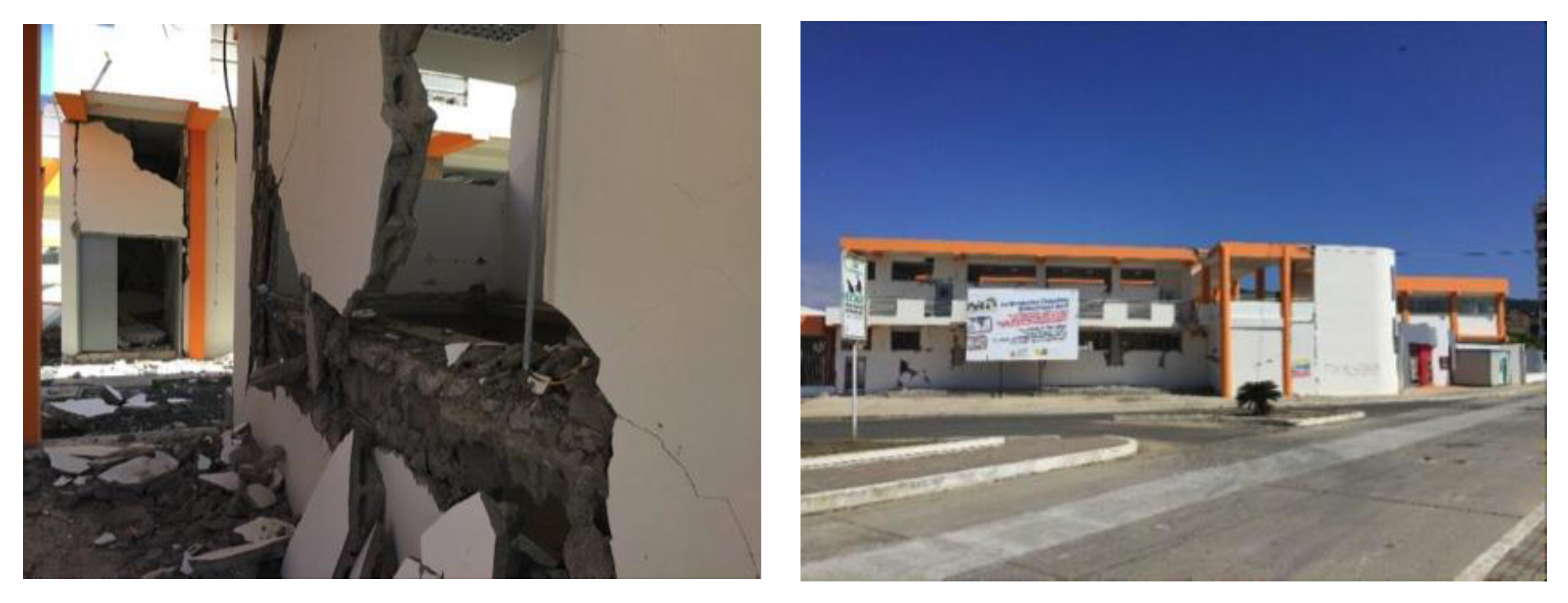
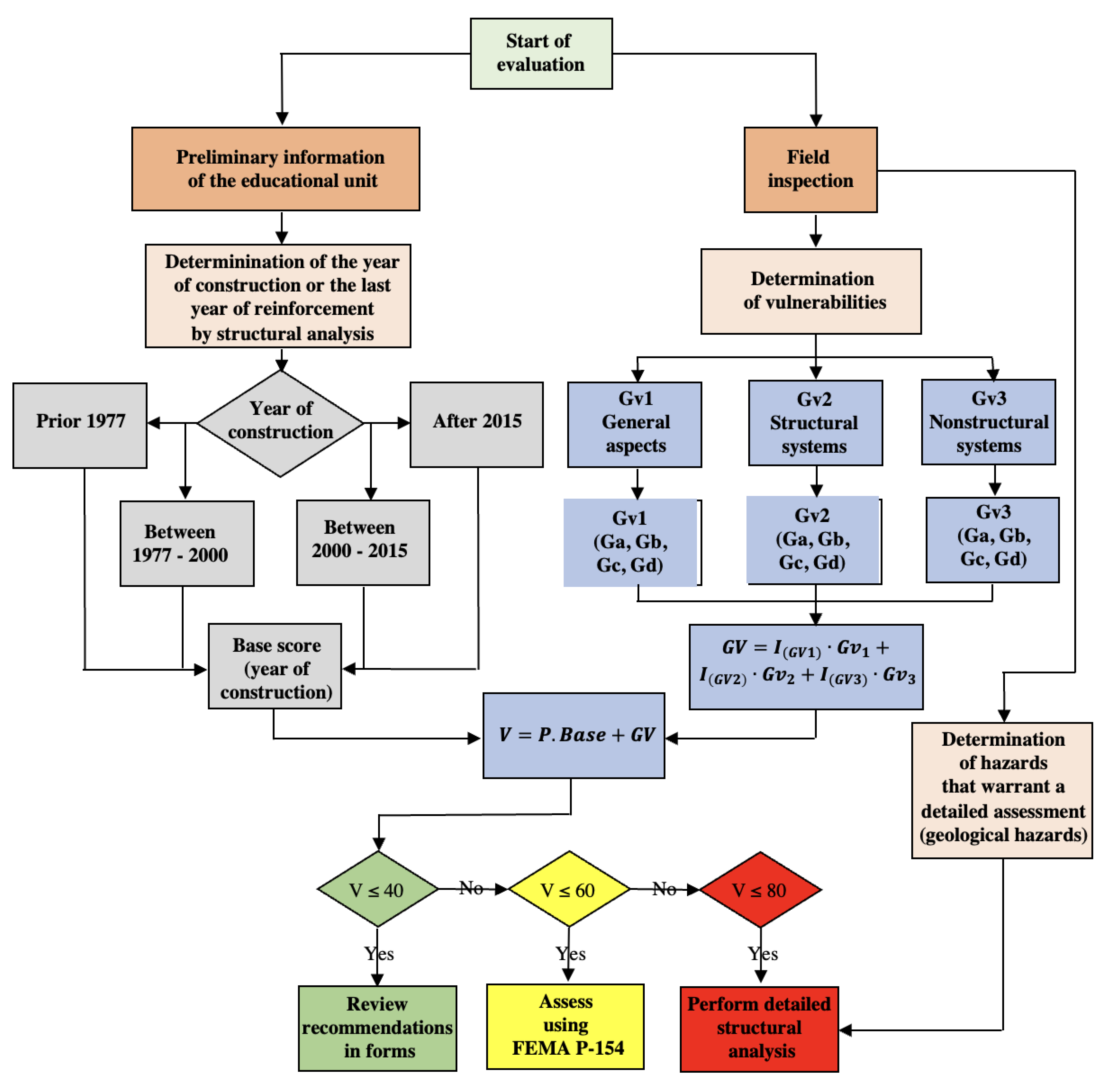
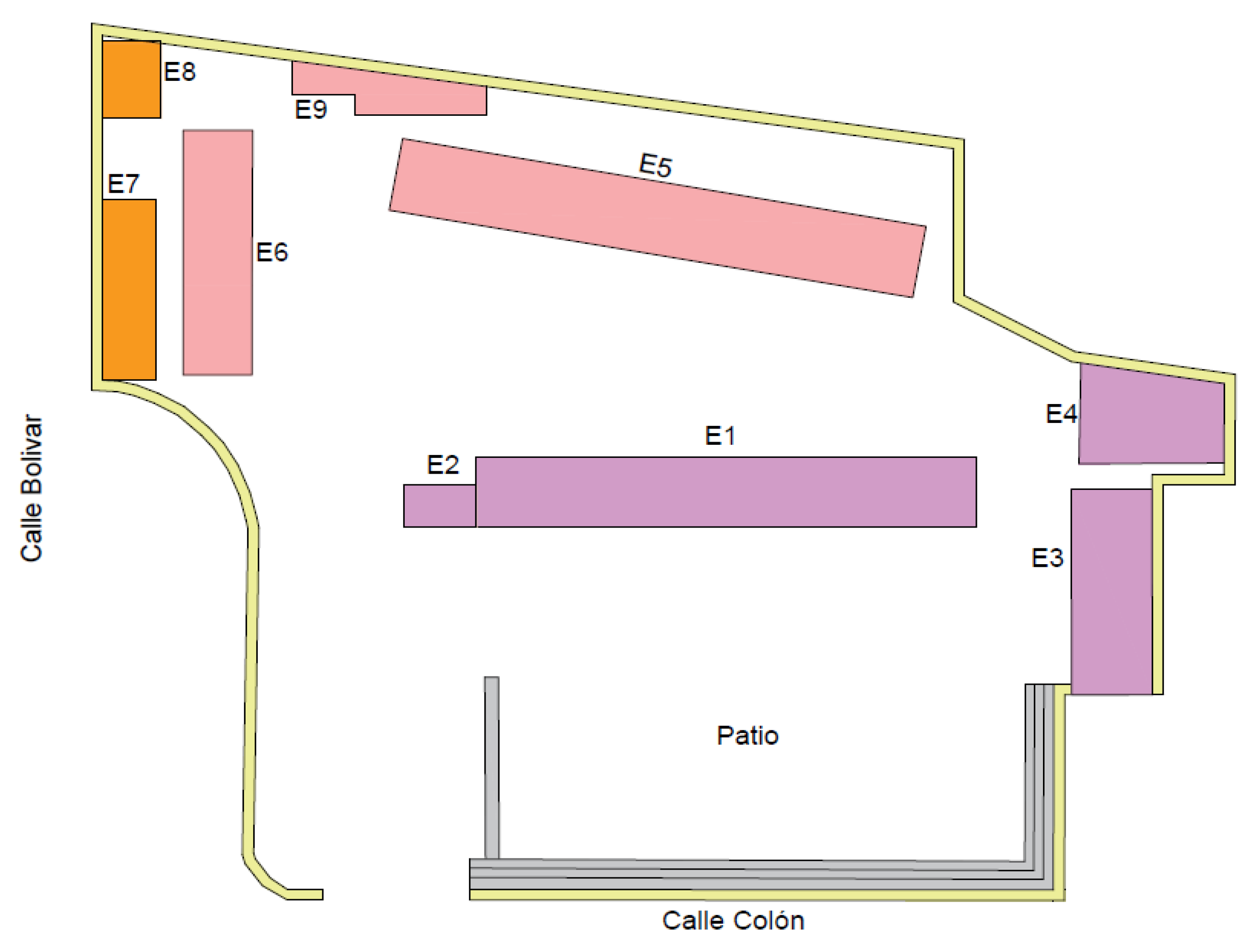
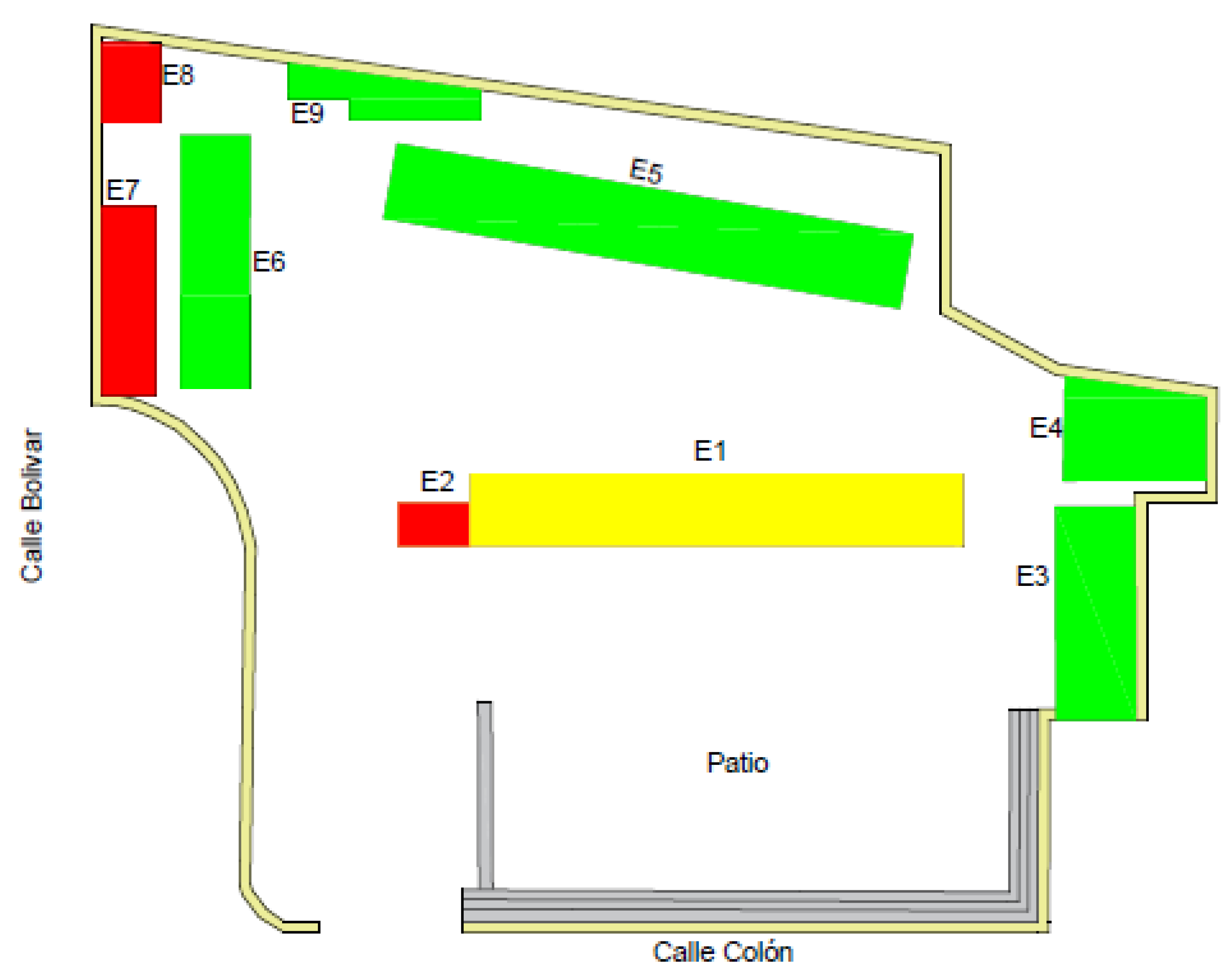
| Earthquake | Date | Mw | Effects on Schools | Observations |
|---|---|---|---|---|
| Olympia, USA | 4/13/49 | 7.1 | 10 schools collapsed, and 30 schools were damaged. | Only 2 children died due to a school break day. |
| Kern County, USA | 7/21/52 | 7.7 | 1 school collapsed, 15 suffered severe damage, and 15 moderate damage among the 58 schools. | Only 1 school suffered moderate damage among the 15 schools built after the Field Act. |
| Skopje, Macedonia | 7/26/63 | 6.1 | 44 schools were destroyed out of a total of 77 schools in the city. | It took place at 5:17 a.m.; thus, thousands of lives were saved. |
| Peru | 5/31/70 | 7.7 | 6730 classrooms collapsed, and hundreds of schools were seriously damaged. | Even though this event caused some 70,000 deaths, there were no school victims due to the time of occurrence. |
| El Asnam, Algeria | 10/10/80 | 7.3 | 70% of El Asnam schools were destroyed. | Experts reported a disproportionate level of damage to schools. Low loss of life due to time of occurrence. |
| Kobe, Japan | 1/17/95 | 6.9 | 4500 campuses with extensive structural and nonstructural damage. | It happened very early in the morning; therefore, no victims were recorded. |
| Nazca, Peru | 11/12/96 | 7.5 | 93 schools seriously damaged. | There were no victims due to schools being in recess. |
| El Salvador | 1/13/01 | 7.6 | 85 schools needed demolition, another 279 suffered serious damage. | 50% of the fatal victims were children. |
| Molise, Italy | 10/31/02 | 5.6 | Collapse of a school and the death of 27 children and a teacher. | The school victims represented 93% of the victims of the earthquake. |
| Xinjiang, China | 2/24/03 | 6.3 | 900 classrooms collapsed. | The students were out of the classrooms in physical education classes and only 20 students died. |
| Banda Aceh, Indonesia | 12/26/04 | 9.3 | 750 schools destroyed in Indonesia, 55 in Sri Lanka, 44 in Maldives, 30 in Thailand. | Earthquake and tsunami; one of the largest magnitudes recorded. |
| Kashmir, Pakistan | 8/10/05 | 7.6 | Widespread collapse of more than 17,000 schools caused some 19,000 children to die. | School buildings were affected in greater proportion than other buildings. |
| Sichuan, China | 5/12/08 | 7.9 | Destruction of at least 6898 school buildings. | 12% of the approximately 80,000 deaths were students and teachers. |
| Pedernales, Ecuador | 4/16/16 | 7.8 | Some 560 schools were damaged, around 88 of them severely. | No fatalities in schools due to time of event. |
| Degree | Description | Score |
|---|---|---|
| GA | Represents a low vulnerability | 20 |
| GB | Represents a medium vulnerability | 40 |
| GC | Represents a high vulnerability | 60 |
| GD | Represents a very high vulnerability | 80 |
| Year Rank | Structural Performance | Base Score | Minimal Vulnerability | Maximum Vulnerability |
|---|---|---|---|---|
| After the year 2015 (NEC 15) | Good performance | 12.5 | 20 | 42.50 |
| Between 2000–2014 (CEC 2000) | moderate performance | 22.5 | 30 | 52.50 |
| Between 1978–1999 (CEC 77) | poor performance | 45 | 52.50 | 75 |
| Before the year 1977 (without norm) | no performance | 55 | 61.25 | 80 |
| No | Condition | GA 20 pts. | GB 40 pts. | GC 60 pts. | GD 80 pts. | |
|---|---|---|---|---|---|---|
| 1 | Condition 1 | X | ||||
| 2 | Condition 2 | X | ||||
| 3 | Condition 3 | X | ||||
| RESPONSE COUNT | 1 | 1 | 1 | 0 | ||
| SCORE | ×20 | ×40 | ×60 | ×80 | ||
| 20 | 40 | 60 | 0 | |||
| SUM | 120 | / | 3 | (Number of form conditions) | ||
| FINAL VULNERABILITY SCORE (V) | 40 | |||||
| I | Base Score | |||
|---|---|---|---|---|
| 12.5 | 22.5 | 45 | 55 | |
| GV1 | 0.2250 | 0.225 | 0.1875 | |
| GV2 | 0.1125 | 0.113 | 0.0938 | |
| GV3 | 0.0375 | 0.038 | 0.0313 | |
| Year of Construction | Height | Degree |
|---|---|---|
| Post-code | Less than 4 floors | GA: 20 |
| Post-code | Greater than 4 floors | GB: 40 |
| Transition period | Less than 3 floors | GC: 60 |
| Transition period and pre-code | Conditions not contemplated | GD: 80 |
| FEMA Buildings | Basic Score | Assigned Grade |
|---|---|---|
| W1 | 1.8–2.1 | GA: 20 |
| S1, S3 | 1.5–1.8 | GB: 40 |
| S2, S4, S5, C2 | 1.2–1.5 | GC: 60 |
| C1, C3, PC, RM, URM | 0.9–1.2 | GD: 80 |
| Range | Degree of Vulnerability (V) | Observations |
|---|---|---|
| 60 < value ≤ 80 | High | A structural analysis needs to be conducted. |
| 40 < value ≤ 60 | Medium | Evaluation through FEMA P-154 to rule out or confirm the performance of a structural analysis. |
| 20 < value ≤ 40 | Low | Consider the recommendations issued by the evaluators. |
| Hazard Exposure Level | Assigned Value |
|---|---|
| Very High | 1.00 |
| High | 0.83 |
| Moderate-High | 0.50 |
| Moderate | 0.25 |
| Low | 0.17 |
| Code (#Floors) | Dependencies | Description |
|---|---|---|
| E1 (3) | (1) 1st to 3rd year of high school, offices | 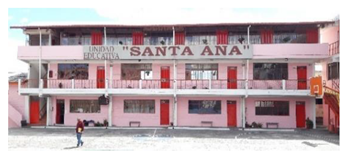 |
| E2 (2) | (2) Chemistry lab, 2nd high school, 10th EGB, audiovisual | 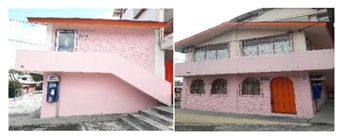 |
| E3 (3) | (3) 6th to 9th EGB, 3rd Bach | 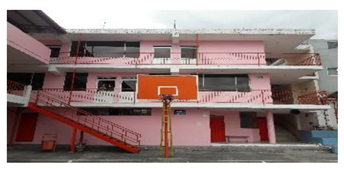 |
| E4 (2) | (1) Collection | 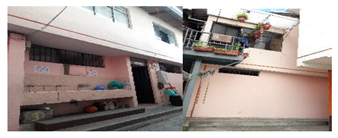 |
| E5 (1) | (2) Chancellorship |  |
| E6 (1) E7 (1) | (1) Medical and dental department, rooms |  |
| E8 (1) | (2) 5th and 6th EGB, computer room | 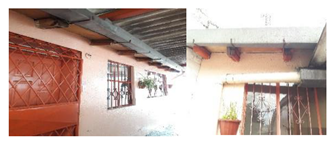 |
| E9 (1) | (3) Classrooms | 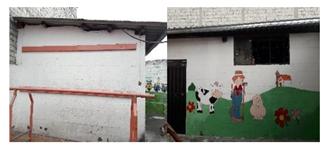 |
| E10 (1) | (1) Bathrooms | 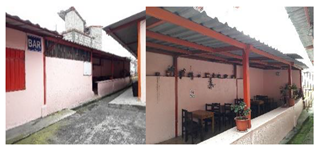 |
| RESPONSE COUNT | 12 | 8 | 5 | 0 |
| ×80 | ×60 | ×40 | ×20 | |
| SCORE | 960 | 480 | 200 | 0 |
| SUM | 1640 | / | 25 | |
| FINAL VULNERABILITY SCORE (V) | 65.60 | |||
| Edif. | Use | V | Terrain Element | VTotal | |
|---|---|---|---|---|---|
| E1 | Classrooms, offices, laboratories | 40.50 | 6 | 6.57 | 43.18 |
| E2 | Offices | 64.51 | 3 | 5.23 | |
| E3 | Classrooms, offices, laboratories | 39.70 | 6 | 6.44 | |
| E4 | Restrooms, janitor’s room | 36.25 | 3 | 2.94 | |
| E5 | Classrooms, laboratories | 36.69 | 5 | 4.96 | |
| E6 | Classrooms | 36.79 | 5 | 4.97 | |
| E7 | Classrooms | 60.66 | 4 | 6.56 | |
| E8 | Cellar | 65.52 | 1 | 1.77 | |
| E9 | Kitchen and dining room | 34.64 | 4 | 3.74 | |
| No | Name | Cr | Vtotal | Rg | Category |
|---|---|---|---|---|---|
| 1 | Liceo Naval | 63.20 | 43.40 | 28.36 | B |
| 2 | Marqués de Selva Alegre | 75.20 | 34.60 | 18.90 | B |
| 3 | Santo Tomás de Aquino | 66.40 | 37.92 | 18.09 | B |
| 4 | Liceo Juan de Salinas | 65.60 | 41.67 | 19.98 | B |
| 5 | Liceo Cristiano Mahanaym | 63.20 | 46.64 | 31.27 | C |
| 6 | Lev Vygotsky | 76.00 | 43.77 | 26.60 | B |
| 7 | Jahibé | 76.00 | 40.04 | 23.63 | B |
| 8 | El Camino | 40.80 | 47.49 | 05.63 | A |
| 9 | Liceo del Valle | 64.00 | 37.62 | 23.40 | B |
| 10 | Cotogchoa | 63.20 | 42.35 | 27.45 | B |
| 11 | San Rafael | 50.40 | 62.70 | 52.45 | D |
| 12 | Santa Ana | 65.60 | 43.18 | 27.75 | B |
| Name of School | Students | Staff | M1 Total | M2 (98%) | M3 (49%) |
|---|---|---|---|---|---|
| Liceo Naval | 2341 | 169 | 2510 | 2459.8 | 1229.9 |
| Marqués de Selva Alegre | 495 | 36 | 531 | 520.38 | 260.19 |
| Santo Tomás de Aquino | 2600 | 44 | 2644 | 2591.12 | 1295.56 |
| Liceo Juan de Salinas | 3300 | 123 | 3423 | 3354.54 | 1677.27 |
| Liceo Cristiano Mahanaym | 160 | 18 | 178 | 174.44 | 87.22 |
| Lev Vygotsky | 1262 | 100 | 1362 | 1334.76 | 667.38 |
| Jahibé | 244 | 16 | 260 | 254.8 | 127.4 |
| El Camino | 150 | 23 | 173 | 169.54 | 84.77 |
| Liceo del Valle | 513 | 33 | 546 | 535.08 | 267.54 |
| Cotogchoa | 924 | 47 | 971 | 951.58 | 475.79 |
| San Rafael | 1345 | 57 | 1402 | 1373.96 | 686.98 |
| Santa Ana | 420 | 29 | 449 | 440.02 | 220.01 |
| Total | 13,754 | 695 | 14,449 | 14,160.02 | 7080.01 |
| Name of School | M4A | M4B | M4C | M4D | M5 | Total Deaths |
|---|---|---|---|---|---|---|
| Liceo Naval | 368.97 | 307.48 | 245.98 | 307.48 | 276.73 | 584.20 |
| Marqués de Selva Alegre | 78.06 | 65.05 | 52.04 | 65.05 | 58.54 | 123.59 |
| Santo Tomás de Aquino | 388.67 | 323.89 | 259.11 | 323.89 | 291.50 | 615.39 |
| Liceo Juan de Salinas | 503.18 | 419.32 | 335.45 | 419.32 | 377.39 | 796.70 |
| Liceo Cristiano Mahanaym | 26.17 | 21.81 | 17.44 | 21.81 | 19.62 | 41.43 |
| Lev Vygotsky | 200.21 | 166.85 | 133.48 | 166.85 | 150.16 | 317.01 |
| Jahibé | 38.22 | 31.85 | 25.48 | 31.85 | 28.67 | 60.52 |
| El Camino | 25.43 | 21.19 | 16.95 | 21.19 | 19.07 | 40.27 |
| Liceo del Valle | 80.26 | 66.89 | 53.51 | 66.89 | 60.20 | 127.08 |
| Cotogchoa | 142.74 | 118.95 | 95.16 | 118.95 | 107.05 | 226.00 |
| San Rafael | 206.09 | 171.75 | 137.40 | 171.75 | 154.57 | 326.32 |
| Santa Ana | 66.00 | 55.00 | 44.00 | 55.00 | 49.50 | 104.50 |
| Total | 2124 | 1770 | 1416 | 1770 | 1593 | 3363 |
Publisher’s Note: MDPI stays neutral with regard to jurisdictional claims in published maps and institutional affiliations. |
© 2022 by the authors. Licensee MDPI, Basel, Switzerland. This article is an open access article distributed under the terms and conditions of the Creative Commons Attribution (CC BY) license (https://creativecommons.org/licenses/by/4.0/).
Share and Cite
Ballesteros-Salazar, K.S.; Caizaguano-Montero, D.G.; Haro-Báez, A.G.; Toulkeridis, T. Case Study of the Application of an Innovative Guide for the Seismic Vulnerability Evaluation of Schools Located in Sangolquí, Interandean Valley in Ecuador. Buildings 2022, 12, 1471. https://doi.org/10.3390/buildings12091471
Ballesteros-Salazar KS, Caizaguano-Montero DG, Haro-Báez AG, Toulkeridis T. Case Study of the Application of an Innovative Guide for the Seismic Vulnerability Evaluation of Schools Located in Sangolquí, Interandean Valley in Ecuador. Buildings. 2022; 12(9):1471. https://doi.org/10.3390/buildings12091471
Chicago/Turabian StyleBallesteros-Salazar, Kevin Sebastián, Diego German Caizaguano-Montero, Ana Gabriela Haro-Báez, and Theofilos Toulkeridis. 2022. "Case Study of the Application of an Innovative Guide for the Seismic Vulnerability Evaluation of Schools Located in Sangolquí, Interandean Valley in Ecuador" Buildings 12, no. 9: 1471. https://doi.org/10.3390/buildings12091471
APA StyleBallesteros-Salazar, K. S., Caizaguano-Montero, D. G., Haro-Báez, A. G., & Toulkeridis, T. (2022). Case Study of the Application of an Innovative Guide for the Seismic Vulnerability Evaluation of Schools Located in Sangolquí, Interandean Valley in Ecuador. Buildings, 12(9), 1471. https://doi.org/10.3390/buildings12091471






